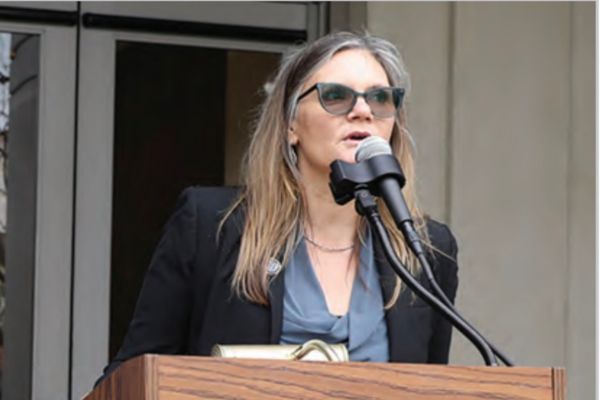As the largest supplier of treated water in the nation, the Metropolitan Water District of Southern California always has considered the big picture to ensure water supply resiliency. Today, that big picture is an action-packed motion picture as climate change brings more frequent periods of extended drought, wildfires and atmospheric rivers.
“A lot of the decisions we made in the past were based on historic data and that worked for us,” said Liz Crosson, Metropolitan’s first chief sustainability, resiliency and innovation officer. “With the unpredictability of climate change and our hydrology today, we need to incorporate this evolving forward-looking, climate-forecasting science and try to better anticipate what the future will look like as opposed to making decisions based on the past.”

Liz Crosson, MWD’s Chief Sustainability Resiliency and Innovation Officer
Crosson, who joined the district in March 2022, leads Metropolitan’s aggressive agenda and plan to reduce its carbon footprint and strengthen its resiliency to climate change. Metropolitan serves 26 public water agencies — cities, municipal water districts and one county water authority — that then deliver supplies directly or indirectly to people in Los Angeles, Orange, Riverside, San Bernardino, San Diego and Ventura counties.
“While ensuring a reliable water supply for 19 million Southern Californians is the core of our mission, we can’t achieve that mission without innovation and environmental sustainability,” said Metropolitan General Manager Adel Hagekhalil. “Liz Crosson brings significant leadership experience and knowledge to Metropolitan that will help us confront the many environmental and infrastructure challenges we’re facing due to our rapidly changing climate.”
Before coming to Metropolitan, Crosson represented Los Angeles Mayor Eric Garcetti on water and climate issues, most recently as his director of infrastructure. She is also an adjunct instructor in urban sustainability at USC Price School of Public Policy. She spoke recently about her role and Metropolitan’s priorities to ensure water reliability for future generations.
As Metropolitan’s first SRI officer how do you define success in this new role?
Sustainability, resilience and innovation are not new to Metropolitan, but creating this office is really about integrating these initiatives and elevating them in a way that showcases the leadership within Metropolitan. It is an opportunity to provide this connective tissue between all our departments and create this umbrella of sustainability in everything that we do.

Metropolitan supplies water to 19 million Southern Californians and also preserves habitats around reservoirs such as Copper Basin that support wildlife such as this red-tailed hawk.
How does climate change challenge the water agency?
I think water agencies have been very successful in adapting to drought cycles. We’ve worked really hard to build our systems to adapt to dry periods of the past. What we’re seeing now is challenging us in a new way. Not only are those droughts longer and more severe, like the ones we’ve seen in the last decade, but we’re now seeing this whiplash effect between extreme dry and wet years that makes water management much more difficult. We need to adapt to these changing conditions accordingly. We need to also think about the impacts of hotter temperatures on the amount of runoff we can expect and when we can expect that runoff. Wildfires also impact some of our source watersheds and the subsequent runoff of sediment can impact water quality downstream. These cascading impacts are demanding our attention right now. We are taking a holistic look at those climate risks so we can adapt our programs, investments, operations and our infrastructure.

Homeowners can conserve with drought-tolerant landscaping, shown above.
At the request of the Board of Directors, Metropolitan is creating a Climate Adaptation Master Plan. What are the top three goals in this process?
First, we need an inclusive process that builds a common understanding between our board, staff and member agencies. Metropolitan is committed to reliability and equity among our agencies, so it is imperative that we build this system resilience together.
Second, we need to develop objective criteria to evaluate how we’re going to adapt to this changing climate. The criteria will include resilience for our system, affordability for our customers and financial sustainability for the region.
Third, we need near-term, no regrets projects to immediately improve the flexibility and connectivity of our water system and produce additional efficiency as a region. The Climate Adaptation Master Plan is a long-range plan, but we need to come away with some immediate projects, particularly those that help to increase water supply reliability for our State Water Project dependent areas. These areas were more vulnerable during the recent California drought because, due to limitations in our distribution system, we were only able to deliver them water from the State Water Project, which was in very limited supply. The nearly 7 million people who live in these areas experienced shortages and emergency water conservation measures in 2022 and early 2023. So, connecting that area to other sources of water is a priority so that we don’t have this issue during future dry periods when our SWP supplies are extremely limited.
Another big piece is doing everything we can in terms of conservation and efficiency. That is always going to be our most affordable option to secure our water supplies. The region has already done really well on water conservation and efficiency, so it’s just figuring out any additional opportunities and what the gaps are. We have to embrace conservation as our way of life whether it’s raining or it’s not.

Copper Basin
What’s the role of technology and innovation in climate adaptation?
Innovation is so exciting right now. What we’re facing in terms of climate change is really inspiring a lot of innovators to look for new ways to track and measure our water use, to eliminate waste, to sequester carbon and to track our greenhouse gas emissions. There is also a lot of innovation in the energy sector. As a large water wholesaler, about 90 percent of our emissions are from electricity use alone, so we’re looking at many ways to use renewable energy. There are a lot of unique opportunities around this water-energy nexus and ways we can be more sustainable overall.
As a water provider how do you balance affordability and sustainability?
I really think affordability and sustainability go hand in hand. Sustainability is all about ensuring what we do and use today doesn’t take away from future generations. So, many of the actions that we take under that sustainability umbrella are actually about reducing waste, using resources more efficiently, and considering the full life-cycle costs and benefits of our actions. A sustainable solution can be affordable when you look at its value over the span of its life cycle.

Diamond Valley Lake in Hemet, California
Metropolitan has a long history of habitat preservation. What are some of the initiatives happening now?
Metropolitan has helped preserve over 30,000 acres of habitat. For example, I recently visited the reserve near Diamond Valley Lake in Hemet and the wildflowers are incredible. This kind of wildlife and habitat preservation also provides a great space for local communities, where people can experience nature first hand.
Metropolitan also purchased four islands in the Sacramento-San Joaquin Delta. The Delta sits at the hub of the distribution system bringing water from the northern Sierra, south to Southern California and its health is critical to the reliability of our water supply. We’re looking at opportunities to restore these historic wetlands to preserve habitat and wildlife and also protect the fresh water corridor within the Delta. There is a lot of subsidence in the Delta and we’re seeing some pretty severe sinking of those islands that can impact water quality and cause other issues. We’re protecting both the habitats and the fresh water corridors we rely on.
Learn more about California Water Magazine.
